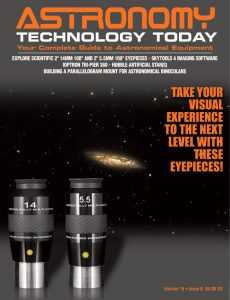This is a great time to be an amateur astronomer. There are lots of good telescopes out there that are relatively inexpensive. Back when I was a teenager, we had no internet, so there was no online shopping, and the telescope stores were few and far between. Sometimes you could find a few in a high-end camera store or discount warehouse. Most were refractors, telescopes that use a lens to gather light, as opposed to reflectors, that use a mirror.
Lots of amateur astronomers back in the sixties would grind their mirrors themselves and build their own scopes as bigger refractors were very expensive. The mounts were often created from plumbing pipe. Most astronomy clubs had classes on how to grind mirrors.
Inexpensive telescopes are often nothing but useless toys. Some are half-way decent, but the mounts are never sturdy enough. Rock-solid mounts are important, or every time you touch your scope, you’ll have to wait a long time for it to stop shaking.
Amateur astronomers have always lusted after the big beautiful scopes found in the catalogs, like adolescents with a Playboy magazine. Unitron was a telescope company that manufactured large refractors mounted on piers that cost thousands of dollars – and this was in the sixties. They were the ultimate dream of the amateur astronomer back then.
Many amateurs lovingly restore old telescopes today. There is a Facebook page titled “Vintage Telescopes.” Poring through its content is like a car enthusiast looking at photos of a restored T-Bird or ’57 Chevy.
In the mid-sixties, an astronomer named John Dobson popularized a new type of reflector telescope that was easy to build and used an inexpensive, yet very stable, wooden mount. Amateur astronomers could now have much larger telescopes for a lot less money. There are now numerous Dobsonian models available from the manufacturers.
Thanks to the computer age, one can now buy telescopes with a “go-to” feature. Once the mount is properly set up, it will locate anything you want to see that is visible and keep it in the eyepiece for as long as you are observing. Obviously, these are more expensive, but there are some relatively cheap models on the market.

A totally new telescope will soon be launched by the French company Unistellar. They did a Kickstarter campaign and encouraged interested investors to pre-purchase their telescopes. It is an astounding piece of equipment with a $2,999 price tag. It’s a small variation of a reflector telescope that uses digital sensors to enhance the incoming light to make the images more like those seen in large telescopes. It is primarily intended for deep-sky objects, such as nebulas, galaxies, clusters, etc. Their information claims it will show images similar to photographs taken by observatories. It sports a fully automatic “go-to” system and can be carried in a backpack. They have partnered with a well-known astronomical institute, and the telescope will enable the observer to share his data with professional astronomers studying that region of space via the internet. Pretty amazing.
I haven’t jumped on the bandwagon yet, as I want the scope to be out for a while first, and let them work out all the bugs before I lay out that kind of money. But it should be a revolutionary development for amateur astronomy, as new observers will no longer be disappointed by the faint images of deep sky objects they often see their first time at the eyepiece.
So, if you’re interested in astronomy, look up the Shasta Astronomy Club website and come out to a star party, or visit the Chico Community Observatory, owned and operated by Kiwanis Club of Greater Chico, in Upper Bidwell Park some weekend night. You might even see me there.
Corky Pickering recently retired from the federal government as an attorney advising law enforcement. He has been a rock and roll bass player and a Marine JAG.
This article originally appeared in the Red Bluff Daily News.
 And to make it easier for you to get the most extensive telescope and amateur astronomy related news, articles and reviews that are only available in the magazine pages of Astronomy Technology Today, we are offering a 1 year subscription for only $6! Or, for an even better deal, we are offering 2 years for only $9. Click here to get these deals which only will be available for a very limited time. You can also check out a free sample issue here.
And to make it easier for you to get the most extensive telescope and amateur astronomy related news, articles and reviews that are only available in the magazine pages of Astronomy Technology Today, we are offering a 1 year subscription for only $6! Or, for an even better deal, we are offering 2 years for only $9. Click here to get these deals which only will be available for a very limited time. You can also check out a free sample issue here.

